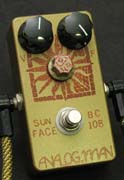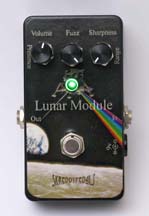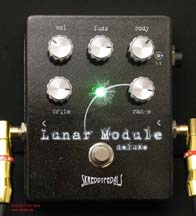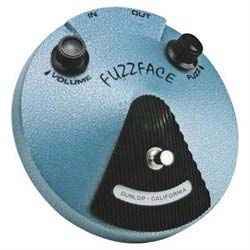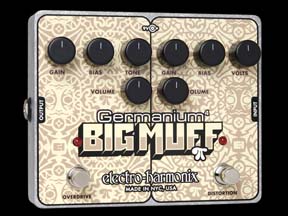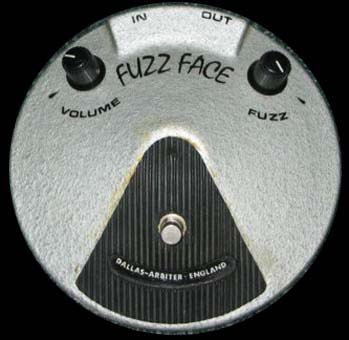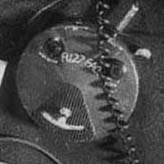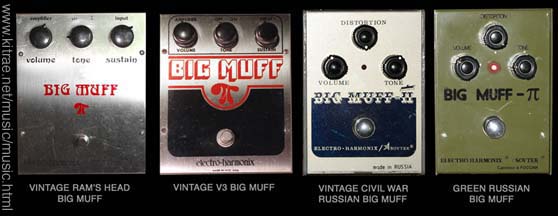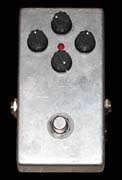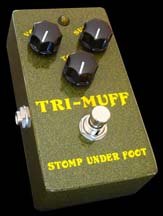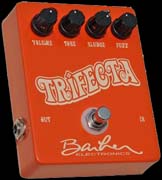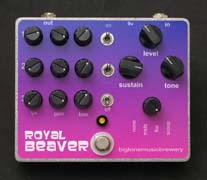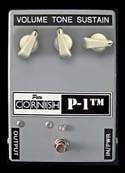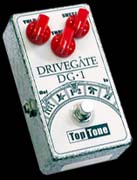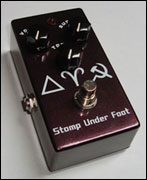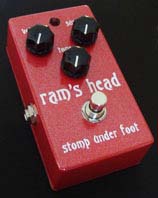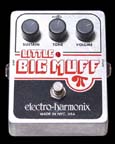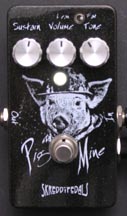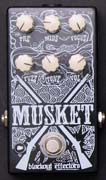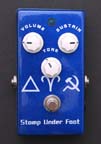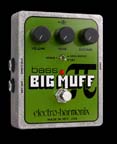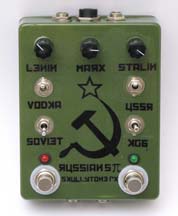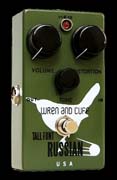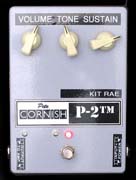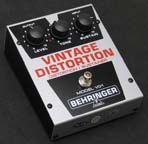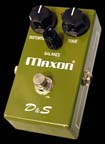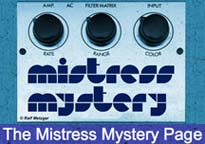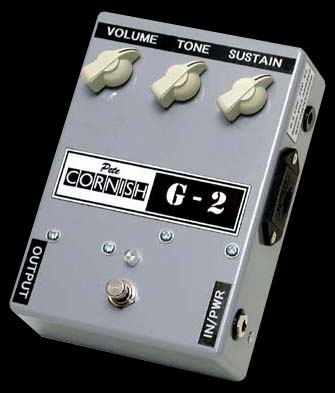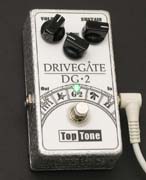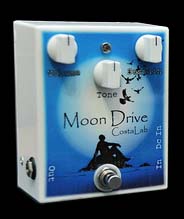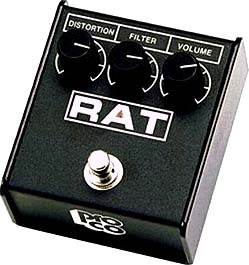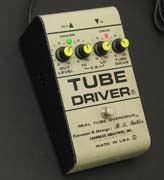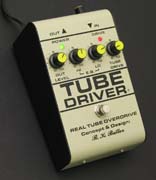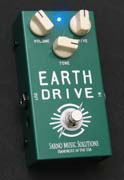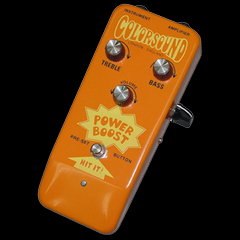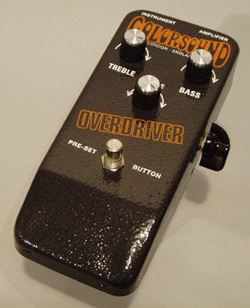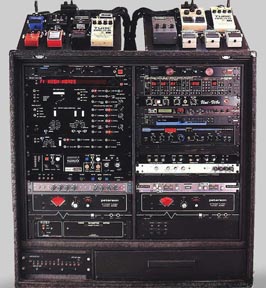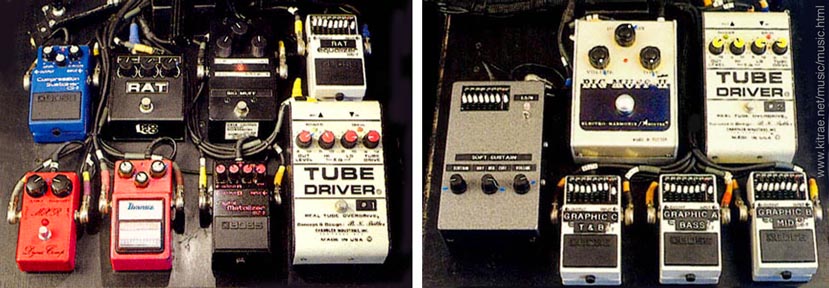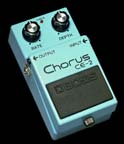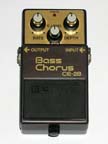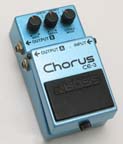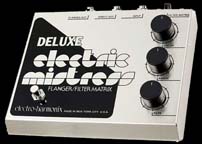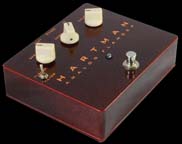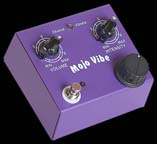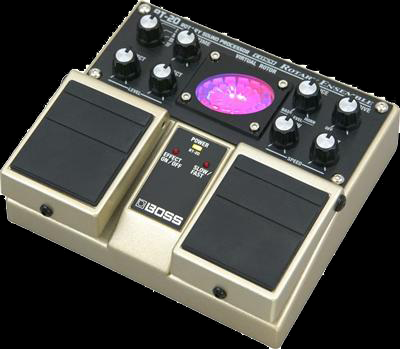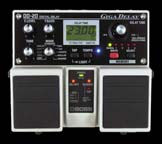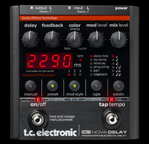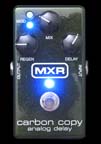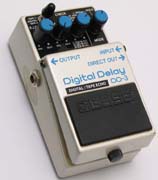NOTE: This website is frequently updated. Last update 2023.
...I generally don't like to say how it's done. I love driving people crazy. They come and say, "How the f--k did you do that? I've been working for months trying to get that.” And I say, "It's just a pedal" - David Gilmour, Guitarist 2006
WHICH PEDALS TO USE FOR THE TONE - The right gear can give you the proper voice to suit Gilmour's tones, but it is equally important to learn how to play in a similar style as him if you want to replicate his sound or incorpotrate it into your own sound. That said, Gilmour does seem to like making it a challenge for people to figure out exactly what gear he used. Below is a guide to the basic effects gear needed to create many of David Gilmour's various lead tones as heard in Pink Floyd studio and live recordings, and David's solo work. I have used every one of these effects at one time or another. This is not a comprehensive list of every effect Gilmour ever used, just a general guide for getting the tones. Includes: compressors, fuzz/distortions, overdrives, equalizer, flangers/chorus and other modulations, and delays.
It goes without saying that you should use a clean amplifier and a Stratocaster or Telecaster type guitar with single coil pickups for the majority of Gilmour's tones. See the Amplifiers and Speakers section for a general guide to the right amp/speaker gear to use.
For early Pink Floyd tones up to the Dark Side of the Moon, Wish You Were Here you need: A Fuzz Face type pedal or clone, a Colorsound Power Boost/Overdriver or similar clone, a compressor, a warm sounding analog type delay, and modulation like a Uni-vibe type pedal or a phaser like a MXR Phase 90 or EHX Small Stone. A vintage style wah pedal, like a Vox Wah, can also be used for some very early Pink Floyd, such as the bird like screams you hear in the middle section of Echoes, and the wailing sounds heard on Is There Anybody Out There.
For Pink Foyd tones from Animals / The Wall / Final Cut era you need: A Ross type compressor, vintage 1970s Big Muff or vintage sounding Big Muff clone, a Colorsound Power Boost/Overdriver or similar clone, a warm sounding digital delay, and modulations like an Electric Mistress or Boss chorus, and a phaser like the MXR Phase 90 or EHX Small Stone.
For Pink Floyd tones from the Momentary Lapse of Reason, Division Bell, and Pulse era you need: A Ross type compressor like the Boss CS-2, Sovtek Big Muff or Sovtek Muff clone, BKB Tube Driver or other smooth overdrive type pedal, warm sounding digital delay, and modulation like Boss chorus and a Uvi-Vibe type pedal. Additional pedals like a Digitech Whammy (for Marooned and The Blue) and a volume pedal can be used for certain songs. An EQ pedal like a Boss GE-7 can also be usefull to sculpt the tone of certain effects, or boost the mids or lows if your amp is lacking in those areas. EMG-SA pickups were also key to the tones from this era.
For David Gilmour tones from the On an Island and Rattle that Lock era you need: A Ross type compressor or optical compressor like the Demeter Compulator, BK Butler Tube Driver, vintage Big Muff, EHX Ram's Head reissue, or a Muff clone like the Cornish P-1, warm sounding digital delay. Additional pedals like a Digitech Whammy (for The Blue) and a volume pedal can be used for certain songs. An EQ pedal like a Boss GE-7 can also be usefull to sculpt the tone of certain effects, or boost the mids or lows if your amp is lacking in those areas. Modulation like Boss chorus and a Uvi-Vibe type pedal can also be used, but David used very little modulation in this period.
Another great resource on the web for David Gilmour's gear is Gilmourish.com. I do not want to repeat the information that can be found there, but I felt since I do my own thing here with sound clips that a general guide to those effects is necessary, but I highly recommend you check out Gilmourish for the comprehensive album-by-album gear guide and some great gear articles and reviews.
The gear links below are organized in the suggested order the effects should be placed in the signal chain
(click on a name to go to that section)
FINGERS > FUZZ > COMPRESSOR > BIG MUFF/DISTORTION > G-2 TYPE OVERDRIVES > BOOSTER/OVERDRIVE > EQ > MODULATION > DELAY > AMPLIFICATION
It is almost cliche to say this, but a majority of what is percieved as Gilmour's tone and sound really does come from his fingers and playing. Gear selection helps, but much of the tone comes from the way the strings are played. Note choice is obviously another key, but you really need to invest the time to learn the picking and tremolo techniques and phrasing to have this solo sound. HERE is a page about Gilmour's playing style.
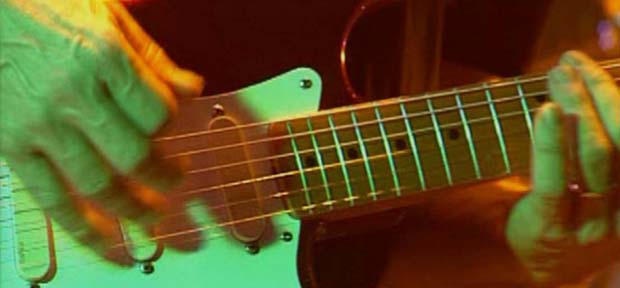
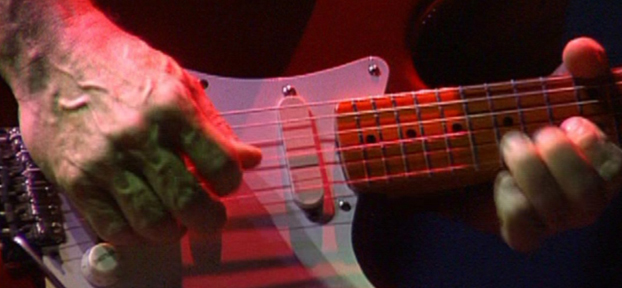
Shown Above: Phil Robinson Silicon Phuzz, Analogman BC108 Sunface with Sundial tone knob, Skreddy Pedals
Lunar Module fuzz, lunar Module Deluxe, Dunlop BC108 Jimi Hendrix Fuzz Face, and Electro-Harmonix Germanium 4 Big Muff
David Gilmour used the Dallas Arbiter Fuzz Face and a Colorsound Power Boost for most of the fuzz tones in the 1970s, through the Dark Side of the Moon, Wish You Were Here, and Animals period. The Big Muff replaced these fuzz pedals for the most part during the Animals tour and there after, so if you are not into replicating those exact 1970s era tones, a fuzz pedal is not necessary. The Fuzz Face is a great pedal though. The familiar solo tones heard in Time and Money are the Fuzz Face into a Hiwatt or Fender amp. The Colorsound Power Boost was an overdrive pedal that Gilmour used for rhythm work, but could also do high gain fuzz, and was possibly used in conjunction with the Fuzz Face for his unique distortion tones.
David owned several Fuzz Faces, likely dozens of them. It is said that some guitarists would go through dozens of them to find ones that souded the best, as the sound varied rom unit to unit. He started using the less reliable early version with Germanium transistors, then sometime during the recording of the Meddle album in 1971, or just after, he changed to the newer and more reliable versions with the Silicon transistors. Some studio photos show two or three on the floor around David. Some concert photos show several on the floor as well. One he is pictured using in the 1972 Obscured by Clouds sessions, and shown in the Mortal Remains exhibition, is a blue FF with the wide raised top, marked Dallas-Arbiter-England. Those were made after the change to Silicon transistors. There are also color photos of a dark blue Dallas-Arbiter FF David used around 1972, and the one in the 1971 Pompeii film was dark blue.
Fuzz Faces are very finicky circuits and there are several issues to be aware of if you have never used one. They must be first in line in the signal chain after the guitar to sound correct. They often do not work well with buffered pedals in the signal chain before or after, as the tone can be negatively affected. They can also occasionally pick up radio stations and CB channels. Vintage Germanium Fuzz Face circuit are very succeptible to temperature, which alters the tone, but the Silicon versions do not have this problem. Fuzz Face circuits also sound best when powered by non alkaline, carbon batteries. I state all that to make you aware that a Fuzz Face is not an easy fuzz to get a good sound out of in a modern rig, but in the right setup, they can sound awesome.
The modern Dunlop Fuzz Face pedals vary in sound quality, partly because the transistors are not screened for the best values, but most of them I have tried sound good. The Dunlop JHF1 Fuzz Face with BC108 transistors is a good one for lower gain, more suited to overdrive tones, and it cleans up very well with the guitar volume nob. The FFM1 mini Fuzz Face has more gain and is better suited to David's more screaming fuzz tones, like the Time solo, Pink Floyd Live at Pompeii, and Animals guitar tones. There are also some great modified replicas of vintage Fuzz Face pedals available. I really like my Analogman Sunface BC108 silicon fuzz. The Sunface is a modified Silicon Fuzz Face with select NOS transistors. I have the Sunface version with the Sundial, a knob which can be dialed to correct the tone back to normal when too cold or too hot for the NKT275 version, but simply acts as fuzz color knob for the BC108 version. It is an internal BIAS trim pot.
![]() Time solo with Analogman Sunface BC108
Time solo with Analogman Sunface BC108
The Silicon Phuzz from Phil Robinson from the UK is probably my favorite Fuzz Face type pedal to play through a Hiwatt. It nails the Live and Pompeii and DSOTM era fuzz tones through my rig, but it really excels at the more aggressive Pompeii sound. It also works much better in a modern pedal board than the vintage style FF circuits. The input circuitry removes radio frequency noise without affecting the clean-up. It runs on standard 9v power and has a power supply isolation stage that removes any high frequency noise emitted by the power supply. It plays well with buffered pedals after it without alterning the tone. It even sounds great and more aggressive with a buffered pedal before it, although that does slightly alter the tone. Below are some sound clips of what this pedal sounds like in a pedal board with a buffered pedal between it and the guitar. Strat with a Seymour Duncan SSL-5 bridge pickup through a Reeves Custom 50 into a Hi-Tone Eclipse 4x12 speaker cabinet.
The Skreddy Pedals Lunar Module from the US is another great fuzz pedal that I highly recommend. It is a custom tailored pedal made by Skreddy Pedals specifically to produce the DSOTM fuzz tones from the album, but it really works for any of Gilmour's fuzz tones, from Live at Pompeii to Wish You Were Here. Although it is not an actual Fuzz Face circuit, it works for most Fuzz Face tones from the 1970s, but is also a very versatile overdrive pedal. It runs on standard 9v power, can go anywhere in the signal chain, plays well with other buffered pedals. It works well with low amp volumes as well as loud.
Another good budget fuzz pedal is the Electro-Harmonix Germanium 4 Big Muff. This is not a Big Muff in the traditional sense, but is a Germanium based fuzz pedal, with an added overdrive side. It is more of a fuzz tone lab. It achieves good representations of David's classic Fuzz Face tones, as well as a wide range of other fuzz tones.
A Vintage Dallas Arbiter Fuzz Face, and one of David Gilmour's original Fuzz Face pedals
VISIT MY SWORDS, KNIVES and FANTASY ART WEBSITE 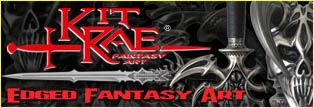 VISIT MY SWORDS, KNIVES and FANTASY ART WEBSITE
VISIT MY SWORDS, KNIVES and FANTASY ART WEBSITE
Shown above (left to right) - MXR Dynacomp, Boss CS-2 Compression Sustainer, Demeter Compulator
David often uses compressors to add some color, smooth gain, or clarity to his solos. A comp is a must for his clean or slightly overdriven tones on songs like Wish You Were Here, Another Brick in the Wall II, Coming Back to Life. A comp can also be used to punch up the attack and sustain for overdrive and high gain solo tones using a Rat, Tube Driver, or Big Muff. Compressors compress the signal (boost lows and compress highs) to add sustain and smooth out the tone. They make the notes a bit more crisp and clear by making light picking and hard picking intensity sound closer to the same volume. The settings Gilmour uses usually create a minimal effect, but his sompressors really helps to smooth out the tone and playing.
David has used many different types of compressors throughout his career, but a few common ones are the MXR Dynacomp, Boss CS-2, and Demeter Compulator. The Boss and MXR are both based around the Ross style compressor circuit and each colors the tone in a unique way. The Demeter is an optical compressor that produces a very pristine compression and does very little to alter or color the original tone. In David's case it seems to have been used more for it's gain boost function than as a compressor. It was almost light drive boost for David's clean tones, as he kept in gain trim pot almost at max in his On and Island touring board.
There are two common types of MXR Dynacomp - a script logo version and block logo version - each with slightly different circuits and sound. The tone and compression of the block logo version sounds similar to the Boss CS-2, but the tone is a bit darker and less bright than the CS-2. The script logo version is a more subtler type of compression.
My vintage script Dynacomp has a tone in between the script reissue and the block logo version, but the tone on those originals varies from unit to unit. It is also a lot noisier than the reissue. The script reissue version is brighter and not as thick/chunky sounding as the block Dynacomp. The block logo version is a bit noisier than the script, but its only really noticeable at high compression, not at Gilmour settings. The script version sounds better in a band mix than the block for most things to me.
David sometimes blended two compressor together, as he did on Pink Floyd's 1994 tour, heard on Pulse. He ran a Boss CS-2 into a script Dynacomp for his compressed clean tones and light drive tones on that tour. The script Dyna is a subtler compressor, so it blends very well with the CS-2. The block Dyna is not as subtle so makes the sound too poppy, chunky, and noisy.
Shown above (left to right) - A vintage "Ram's Head" Big Muff, vintage V3 Big Muff from 1977, "Civil War" Sovtek Big Muff from 1994, and the later Green Russian Big Muff
David's primary fuzz/distortion pedal for solos from 1977 through the 1990s and 2000s was the Electro-Harmonix Big Muff Pi. David is well known for using a vintage USA made "Ram's Head" Big Muff and a Russian made "Civil War" Sovtek Big Muff. He also used several custom Big Muff variants made by Pete Cornish. I have an article about all of David's Big Muffs HERE. David used these pedals throughout his career, and I consider the Big Muff the most important pedal for Gilmour distortion tones. The Muff is not really a fuzz pedal, though it does have some fuzz-like qualities. It is more of a distortion-fuzz mix, with an absolutely huge, deeply mids-scooped tone. It is not an easy pedal to master, but in the right hands and with the right amp it is a very harmonically rich distortion with tons of sustain and character. The unique clipped distortion of the Big Muff circuit makes it very responsive to subtle harmonic intonations when using both the thumb and pick together, something David Gilmour is an expert at doing in his solos. A good vintage Ram's Head/Traingle Big Muff, early V3 Big Muff, or Sovtek "Civil War" Big Muff are the ultimate pedals for David's Big Muff tones, however finding a good vintage unit can be difficult. Vintage units are typically very expensive, can be rather fragile, and many only run on batteries. There is also the other problem that many do not sound the same due to wildly varying component values and tolerances. This means some may sound great for Gilmour tones, and others not so great. For reference, I have a page of sound clips of dozens of original vintage and new Big Muffs HERE, using examples dating as far back as 1970. This pedal has a long history, covering many, many versions. See my Big Muff Page website HERE for information and a comprehensive history of this famous pedal.
So if you don't go the vintage route, which modern Big Muff or clone should you use? The sheer number of Big Muffs abd clones avaialble make the choices confusing, so I will try an narrow it down a bit. Below are Muffs and clones broken down by "clone" type. Some of these have additional controls that make them more versatile and able to cover more than one Big Muff circuit sound, and allow them to work on a variety of amps. Any Muff clone with a mids knob is a great choice because the mid range is usually where the Muff gets muffled and lost on certain amps. In that regard, the BYOC Large Beaver (ram's head or tri spec), Big Tone Music Brewery Royal Beaver, and the Blackout Effectors Musket and the absolute best choices.
WHICH BIG MUFF OR CLONE SHOULD I USE? - I get asked all of the time, which Big Muff is best for Gilmour tones? The answer is, there are many, and the best one for you depends a lot on your gear and which Gilmour/Floyd era you are going for. There are many clones that replicate various vintage Big Muffs or that have Muff based circuits that work just as well for Gilmour tones as the original Big Muffs, some perhaps better. These are far less expensive and more reliable than the original pedals, and many include added features or controls. I have a page HERE of some of my favorite Big Muff clones and modified boutique pedals with Big Muff based circuits, with sound clips. One question I hear a lot is "should I use aTriangle or a Ram's Head type Big Muff?". Just to clarify, there is no single specific sound or schematic that defines a Triangle from a Ram's Head when looking at the real vintage pedals. There were many circuit variants for each, and both covered the same variations in components values from circuit to circuit, and thus the same wide variety of sounds. It is hard to find two that sound exactly alike. You could take a few dozen Triangles and find 4-5 really different sounds, and find the same 4-5 different sounds with a few dozen Ram's Heads. The modern definitions of what each is "supposed" to sound like I believe came from the first popular tracing schematics (pisotones.com) and popular clones from the late 1990s-early 2000s (BYOC Large Beavers). Those were based on a just few specific examples. However, Sovtek Big Muffs and most Sovtek clones in general DO have a specific, common tone. I use these common definitions of the sound to group the various Big Muff types.
TRIANGLE TONES = heavy bottom end bass, moderate gain, smooth and articulate tone, scooped (removed) mid range.
RAM'S HEAD TONES = light bottom end bass, more gain that a Tri, thick and gritty tone, deeply scooped (removed) mid range.
SOVTEK TONES = heavy bottom end bass, lowest gain of the three, very smooth and articulate tone with a slight amount of grit, almost flat (less removed) mid range.
Just about any Big Muff will sound good on a large, loud, clean tube amp with lots of head room, such as a Fender Twin Reverb or Hiwatt Custom 100. It gets a bit trickier when you are using smaller amps or single speaker combo amps, especially when you play at low volume. Fat, bassy, high gain Muffs may sound muddy and messy, so thinner, or lower gain sounding Muffs are usually a better way to go. Muffs with selectable mids switches or mids knobs also help tune the Muff to sound better on smaller amps. Tube amps are best to use, although I have heard a few solid state amps that work with Muffs, but not many.
TRIANGLE TONES (left to right) - BYOC Large Beaver (Triangle spec), Stomp Under Foot Tri-Muff, Barber Trifecta, Big Tone Music Brewery Royal Beaver
TRIANGLE SOUND = heavy bottom end bass, moderate gain, smooth and articulate tone, scooped (removed) mid range. Blends OK with most drive/boost pedals, though though too much gain can make the sound break up, and some drive pedals can make the sound too bassy.
RAM'S HEAD TONES (left to right) - Pete Cornish P-1, TopTone DriveGate DG-1, Stomp Under Foot VRH, BYOC Large Beaver (Rams Head spec), , Big Tone Music Brewery Royal Beaver, MJM Foxey Fuzz, Barber Trifecta, Stomp Under Foot 73 Ram's Head, Electro-Harmonix Little Big Muff, Skreddy Pig Mine.
RAM'S HEAD SOUND = lighter bottom end bass, more gainy and biting than a Triangle, thick and gritty tone, deeply scooped (removed) mid range. Blends OK with most drive/boost pedals, though too much gain can make the sound break up.
SOVTEK STONES (left to right) - Blackout Effectors Musket V2, Stomp Under Foot CWM (Civil War Muff), Electro-Harmonix Bass Big Muff, Skullytone FX Russian Spi, Big Tone Music Brewery Royal Beaver, Pete Cornish P-2, TopTone DriveGate DG-1.
SOVTEK SOUND = heavy bottom end bass, lowest gain of all, very smooth and articulate tone with a slight amount of grit, almost flat (less removed) mid range. Blends very well with most drive/boost pedals.
MUFF SUBSTITUTES - The Behringer Vintage Distortion and Maxon D&S reissue are both modified Big Muff clones that sound good on small combo amps where thicker, bassier, more agressive Big Muffs may not work as well. The D&S is very low on bass and features a less mids scooped tone control, allowing it to cut through a variety of amp circuits while still retaining a Big Muffish tone character. The tone control must be set completely counter clockwise for best tone. The Behringer Vintage Distortion is also less mids scooped, but has slightly more bass, a better tone control than the Maxon, though it has slightly less gain.
RECOMMENDATIONS BY DAVID GILMOUR ALBUM ERA
1977 Animals / In the Flesh tour era - David had a very dry, bright and gritty sounding Big Muff tone, especially for the In the Flesh / Animals tour, heard best on the 1977 Oakland, California bootleg. David used a Ram's Head Big Muff and the Pete Cornish P-1, which was a high quality Ram's Head Big Big Muff clone, likely similar to the Violet schematic Ram's Head Big Muff. The Animals Big Muff tone is tricky though, even with a decent Ram's Head era Big Muff. David got a very hairy, Fuzz Face-ish scream to it by combining it with a Colorsound Power Boost. Another key to that hairy, splatty Animals Muff tone is VOLUME and natural speaker breakup. It must be played right on the edge of feedback. Another crucial element to the tone is that this is a combo setup of A Hiwatt DR103 and a Yamaha RA200 rotating speaker cabinet. The Yamaha is on most of the time and this has a huge affect on the color of the tone.
I recommend the Pete Cornish P-1, BYOC Large Beaver (Triangle spec is smoother for the studio tones, Ram's Head spec is grittier for the live tones), Stomp Under Foot VRH (based on the Violet Ram's Head, but thicker and fuzzier), or the MJM Foxey Fuzz. The Big Tone Music Brewery Royal Beaver is sort of a Big Muff tone lab, and can be set for similar tones to this, and other Big Muff Triangle/Ram's Head tones. The Skreddy Pig Mine is another Muff based pedal that works here, though it has brighter mid tones and less bass than many of the others mentioned, but that allows it to work on a wider variety of amps.
1978-1983 Gilmour solo / The Wall / Final Cut era - Some of David's most well known Big Muff tones are from this period, including the Comfortably Numb solos, and almost all of the solos on David's first solo album and Roger Waters The Final Cut album. Thick, articulate, and a bit gritty, similar to the Animals period.
I recommend the Pete Cornish P-1, Stomp Under Foot VRH (Violet Ram's Head) or 73 Ram's Head, MJM Foxey Fuzz, Barber Trifecta, BYOC Large Beaver Ram's Head spec (grittier) or Triangle spec (smoother). The Skreddy Pink Flesh and Pig Mine are also good Muffs to use for this era, though they have less bass and more mid tones than a mids scooped Big Muff like a Ram's Head. The Big Tone Music Brewery Royal Beaver is sort of a Big Muff tone lab, and can bet set for similar tones to this, and other Big Muff Triangle/Ram's Head tones. The Electro-Harmonix Little Big Muff is a good budget pedal for these tones.
1984-1987 About Face / guest performances era - David mostly used the Boss HM-2 distortion in this period, with the occasional use of a Ram's Head Big Muff. I also hear the occasional use of the ProCo Rat. The HM-2 can be found used on ebay, and the Rat is still being made. I have found a Triangle/Ram's Head style Big Muff also works fine for anything from this era, but a lot of the signature tone was the HM-2 combined with a Mesa Boogie amp, or the HM-2 used as a driver into a Big Muff, through a Fender Twin Reverb.
1987-1990 Momentary Lapse of Reason / Delicate Sound of Thunder era - David's Big Muff tones were similar to The Wall era tones, but he also used the Boss HM-2 again, and a ProCo Rat. On the Turning Away and Yet Another Movie are the two stand out Big Muff tracks from this time for the live period. The live versions of Sorrow are also the Big Muff.
I recommend the same pedals from the 1978-83 era listed above. The Pete Cornish P-2 is another pedal that can be used for these tones, and David used one in 1988. It is similar to the smooth Civil War Big Muff sound, but the mid tones are voiced brighter on the P-2, and the pedal has a large, deep, bottom end. The "Civil War" Russian Big Muff also works good for these tones, as does the Skreddy Pink Flesh and Pig Mine. The Electro-Harmonix Bass Big Muff, is excellent for these tones when used with a compressor or Tube Driver.
1993-1994 Division Bell / Pulse era - David's main distortion seems to have been the Ram's Head Big Muff in the studio, but live he used the Sovtek "Civil War" Russian Big Muff as his primary distortion. This version of the Big Muff was very smooth, bassy, featured brighter mid tones, and was not as high gain as the USA made Big Muffs. David also used the ProCo Rat again. This era is known for the famous "Pulse" tone, from the live album and concert film, and that distortion tone comes from the Civil War Big Muff. Keep Talking and High Hopes are two stand out Big Muff tracks from this era. What Do You Want from Me may also be the Big Muff. Practically all of the disortions heard on the tour and the Pulse album and concert film are the Civil War Big Muff.
I highly recommend the Blackout Effectors Musket, an exellent pedal that can reproduce the full range of Civil War/Sovtek Big muff tones, and it includes extra features like a mids control and a pre-gain control which almost acts as a compressor. The Stomp Under Foot CWM is a very accurate, and highly recommended, reproduction of the Civil War Big Muff. The Wren and Cuff Tall Font Russian is based on the Civil War Big Muff circuit. The Pete Cornish P-2 is another pedal that can be used in place of the Civil War Big Muff. It is similar to the smooth Civil War sound, but the mid tones are voiced brighter on the P-2, and the pedal has a large, deep, bottom end. I think the P-2 was there as a backup for the Civil War Muff in '94, but was rarely used. The TopTone DG-1 is a very good clone of the P-2. The Skullytone FX Russian Spi is another very versatile Russian Big Muff style pedal. The BYOC Large Beaver Triangle spec version with the EQ switch in mids boost 1 position also sounds very similar to the Civil War Big muff and Cornish P-2, as does the Big Tone Music Brewery Royal Beaver in mids boost position 1. The Skreddy Pink Flesh and Pig Mine also work nicely for these tones, with smooth bright mids, but have a bit less bottom end than the Civil War Big Muff. Electro-Harmonix has discontinued the Russian made Sovtek Big Muffs, but they replaced it with the Bass Big Muff, which has a similar sound, and is excellent for these tones when used with a compressor or Tube Driver.
2001-2002 Meltdown concert era - David had the Ram's Head Big Muff and the Pete Cornish G-2 for these concerts. I don't hear the Big Muff much, but I hear the BKB Tube Driver and the Cornish G-2 a lot. The G-2 is based on a Big Muff, but the unique circuit tweaks make this Muff sound like a Muffish overdrive, kind of like a Rat/Muff/overdrive combo. The only pedal I know of that sounds like the real G-2 is the TopTone DG-2. The Costalab Moon Drive is another G-2 clone. A ProCo Rat would be an OK substitute, though not quite the same sound.
2006 On an Island / Remember That Night / Gdansk / Roger Waters 2011 Wall era - David again used the Ram's Head Big Muff and Tube Driver for the studio recordings. For the OAI tour David had the Pete Cornish G-2 and the Pete Cornish P-1, but I think David used the Tube Driver for most of the guitar solos. For the Roger Water 2011 Wall performance of Comfortably Numb, I believe David used the Cornish P-1. See the 2000-2001 entry above for Cornish G-2 recommendations.
For the P-1 Ram's Head Big Muff tones, I recommend the TopTone DG-1 as the closest match, then the Stomp Under Foot VRH as econd closest. The BYOC Large Beaver Ram's Head spec or Triangle spec, the Stomp Under Foot '76 Ram's Head, MJM Foxey Fuzz, Barber Trifecta, or the Big Tone Music Brewery Royal Beaver are also close. The Electro-Harmonix Little Big Muff is a good budget pedal for these tones, though not quite the same sound.
MAGIC TONE AND MUDDY MUFFS - There is a "magic" area for the tone knob setting on a Big Muff that puts it in the Gilmour territory, and that is around 35-40% /10:30-11:00 from true zero. Too low and it will sound muddy and lack clarity, and too high it will sound bright and harsh. It will vary depending on how bright your amp and other gear is set. Another thing to note is that Big Muffs have a very "scooped" tone, meaning they lack mid range in the EQ spectrum because they have been scooped out by the circuit. This makes the tone sound huge for solos, but it also means the Big Muff occupies much of the same EQ space as the bass guitar and bass drum in a band. This can sometimes cause the Muff to get lost in a band mix and sound muddy. Adding mids with the EQ knobs on a boost/blend pedal like a Tube Driver, adding mids with an EQ pedal, adding mids with a mids knob on some Big Muffs, or simply compressing the Muff tone with a compressor pedal to add clarity, can correct that problem. Some Big Muff based pedals such as the P-2 have mids added to the circuit already or have mid boost switches, like the Skreddy pedals. Others have adjustable mids knobs built in, like the Blackout Effectors Musket, BYOC Large Beaver, and Big Tone Music Brewery Royal Beaver.
MUFFS TO STAY AWAY FROM - These are not bad sounding Big Muffs and clones by any means, just not the best for Gilmour tones: Way Huge Swollen Pickle (Dunlop) , Electro-Harmonix USA reissue Big Muff Pi (2007 large box BMP).
Shown above (left to right) - Pete Cornish G-2, TopTone DriveGate DG-2, CostaLab Moon Drive, and Proco Rat
For the Meltdown and On an Island era David used the Pete Cornish G-2 heavily for his guitar solos. It is a very unique sounding variation of a Big Muff circuit. It has an almost overdrive like sound, reminiscent of a Marshall amp tone. It is not a very high gain pedal, but has a thicker sound than most overdrives, and a very unique character. Similar pedals are the TopTone DG-2 and Costalab Moon Drive. The ProCo Rat can also be used as a substitute, though it is not quite the same sound.
Left to Right - The old Chandler Tube Driver made without designer B.K. Butler's authorization, the better B.K. Butler/Chandler Tube Driver (the "Pulse" era TD) and the reissue Tube Drivers hand made by B.K. Butler
The Tube Driver is a booster/overdrive pedal. It replaced the Colorsound Power Boost David used in the 1970s and Pete Cornish ST-2 Booster (Power Boost clone) from the late 1970s. He used this pedal for his light and heavy overdrive tones heard in songs like Coming Back to Life, Marooned, A Great Day for Freedom, and the live versions of Shine on You Crazy Diamond. It was also used to boost/lend with his Big Muffs. David used two BK Butler/Chandler Tube Drivers in his 1990s live rig. One was set for overdrive, and one was set for light drive clean tones, and to use with the Big Muffs. Gilmour's 2006 board used two new B.K. Butler hand made Tube Drivers in the same manner. There are many other versions of the Tube Driver. I have played most of them and I suggest staying away from any but the three shown above. The BKB Chandler version is my favorite, though the later BKB made version sounds practically identical, though settings need to be different to capture the exact same tones.
The Sarno Music Solutions Earth Drive, Boss BD-2 Blues Driver with Keeley "fat" mod, and Skreddy Pedals Lunar Module Deluxe
Tube Drivers are expensive and many people cannot get along with them. They sound best with Hiwatt type amps and some vintage style Fender amps to me, but are not very versatile with other amps. They are also large, taking up considerable space on a pedal board, and use a vacuum tube that eventually will need to be replaced. There are however many overdrive pedals that offer similar light boost and overdrive tones that work great for Gilmour tones. The Skreddy Pedals Lunar Module Deluxe, SMS Earth Drive and the Boss Blues Driver are three of my favorites. The Earth Drive is superb for Gilmour. It is similar to the Blues Driver, but the BD can sometimes come across as harsh. Nothing about the ED is harsh. It is one of the smoothest, most useful overdrive pedals I have ever used. It is also one of the best Big Muff blend pedals available. The Blues Driver is not quite as smooth, but it does a good job, and has more gain on tap than the ED. The Skreddy Lunar Module or the deluxe version, are excellent for very smooth and creamy overdrive tones (with fuzz dialed off), and this pedal is probably my favorite. The Lunar was tailored specifically for Gilmour fuzz and overdrive tones. Some other good overdrives are the Vintage Effects ColorDrive, and the Throbak Overdrive Boost. The Blackout Effectors Musket also does very nice overdrive tones an addition to great Muffish fuzz tones. Some other good ones, but on the expensive side are the Skreddy Screw Driver, Pete Cornish SS-2, and Pete Cornish G-2 fuzz.
The Colorsound Power Boost and the Colorsound Overdriver
One of David's primary overdrive pedals from the 1970s was the very rare and expensive Colorsound Power Boost. It is a great pedal for some of David's vintage 1970s overdrive tones, especially his live tones from this period, but not as usable for other tones as the pedals listed above. It is still still distributed by Macari's of London, hand made for them by Jake Rothman/Theremin.co.uk. Macaris also sells the revised version called the Overdriver, which includes a master volume. The Overdriver circuit is almost exactly the same as the Power Boost, but with more gain on tap. Though it is an overdrive and not technically a fuzz, it does some great fuzz tones when the drive is almost at 10. You can also find less expensive clones like the Throbak Overdrive Boost, or even the Skreddy Lunar Module and Boss BD-2 Blues Driver can produce some similar tones. I use the Overdriver for much of the light overdrive tones and some fuzz tones for DSOTM and WYWH, and as a light boost after the Sunface/Fuzz Face. I leave the pedal on all the time with a light setting - a trick I learned from Gilmourish.com. It really makes my tube amp sound better. The Overdriver is a bit difficult to use on a pedal board with other pedals set for unity gain/volume, as the Overdriver is very loud.
David Gilmour's 1994 custom Bob Bradshaw modded effects rig, with Phil Taylor's pedals-to-rack rack setup. Cornish modded effect pedals are mounted on top of the rig, including two BK Butler/Chandler Tube Drivers. Note the blue tick marks by the knobs in these enhanced photos, indicating that the settings in these press photos are likely Gilmour's actual settings. The tick marks are to ensure the pedal settings are the same from show to show. Gilmour has similar marks on his 2006 all-tube Pete Cornish board.
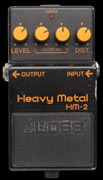
An essential pedal for David's 1984-1987 About Face / guest performances era and his 1987-1990 Momentary Lapse of Reason / Delicate Sound of Thunder era, first introduced in late 1983. Don't be fooled by the name. While the pedal was popular with 80's metal hair bands and Swedish death metal bands (turn all knobs 100% up and play into a dirty amp for that tone), it is also very versatile. It does a unique overdrive tone (used for the overdrive chords in On the Turning Away) to full on distortion, as heard on many MLOR and DSOT guitar solos. The HM-2 has the unique ability to sound both mid range scooped and mid boosted at the same time.
The pedal has a split tone section, but not a typical treble and bass control setup. The L knob does control the bass level, but the H knob, which one would assume raises or lowers the treble, is actually tied to the mid range EQ, allowing a complete mid range scoop or massive boost. On the right side resides the Gilmour mids boost, which is part of this pedal's siganture tone. It is best to blend the it with a dirty amp, an overdrive, drive or fuzz pedal. The HM-2 can be found used on ebay.
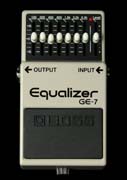
David sometimes uses an equalizer to alter his guitar tones, adding some subtle tone shaping. Big Muffs have a very "scooped" tone, meaning they lack "mids" in the EQ range. This makes the tone sound huge for solos, but it also means the Big Muff occupies much of the same EQ space as the bass guitar does in a band. This can sometimes cause the Muff to get lost in a band mix and sound muddy. Adding some mids with an EQ can correct this problem.
David's primary EQ was the Boss GE-7. He had three of these in his Division Bell rig and in his custom Pete Cornish pedal boards. I use it to add a bit more bass and highs to my Big Muff tone. Best when used at light settings to avoid adding hiss and noise to your signal. Some people prefer to boost mids and cut bass to make their Big Muff's stand out more in a band mix, or slightly boost the volume for solos.
Left to right - The excellent Boss CE-2, The CE-2B with mix knob (same CE-2 circuit with one cap changed), the not so excellent Boss CE-3, and the better CE-5 chorus ensemble with mix knob, the Deluxe Electric Mistress flanger, Hartman Flanger, MXR Phase 90 phaser, the Sweetsound Mojo Vibe, and the Boss Boss RT-20 Rotary Simulator
David's solo tones are almost always modulated and "liquid" sounding. David first created this sound with rotating speaker "Leslie" type cabinets in the 1970s, then he started using a Uni-Vibe, a phaser, then a flanger, then a chorus - but all were used to accomplish the same thing - adding a light, modulated swirly sound to create space and depth in the tone. One of his most used modulation effects, besides rotary speaker cabinets, was the Boss CE-2 chorus. It is a very rich and warm sounding modulation. David had one amp dedicated to the CE-2 in his Division Bell / Pulse rig, so it was not 100% in the mix. The CE-2 was used for almost every song on Pulse, especially on his Big Muff solos. For a few songs David has also used an MXR Phase 90 and a Univox Uni-Vibe. The Uni-Vibe simulated the swirly sound of a Leslie type rotating speaker cabinet and the Phase 90 create a phased sweep that oscillated through the tone. A huge part of David's modulated sound both in the studio and live are his Leslie type rotating speaker cabinets like the Rover, Yamaha RA-200, and Doppolas. In 2006 Gilmour changed to a simpler tone with very little modulation.
PHASER - David used an MXR Phase 90 in the mid 1970s for the Wish You Were Here studio album recordings and in his live rigs from 1974-75. He changed to a Phase 100 in 1976, but the classic recordings he is known for used the Phase 90. The standard MXR Phase 90 works very well for these tones, but the smaller Phase 95 is much more versatile and allows the depth of the phase to be adjusted. Switching from the Phase 90 to the Phase 45 setting cuts the four-stage effect to a two-stage, reducing the effect depth. Switching the "script" button changes from a more dominant phase sweep to a more subtle sweep. These options allowing the Phase 95 to work better with a wider range of rigs and effects.
The EHX Small Stone is another good phaser, but I find the phase sweep is too deep to replicate Gilmour's phase effects properly.
BOSS CE-2 CHORUS - The Boss CE-2 is one of my favorite effects. I find it works best for the rotary speaker type effects I hear on The Wall studio recording (mixed with rotary cabs and non rotary cabs), and in combination with the Electric Mistress for The Wall 1980-81 live tones. It is a very dominant effect, almost too much for my liking, though not as strong as the Mistress. In David's later 1980s and 1990s rigs he usually only had the CE2 going to only one channel of his stereo rigs, so it was essentially 50% in the mix. To cut the effect back a bit I have used a two amp setup, with one amp dedicated the chorus (as Gilmour did on the Division Bell tour, heard on Pulse). I have also used a loop pedal with a mix knob to mix the chorus into my signal as desired.
I later found the Boss CE-2B was almost exactly the same circuit as the CE-2 but included a mix knob so you can get those 50% chorus mixes that David used in a mono rig. It also cost far leass on the used market than the CE-2. The 2B is tuned slightly different for bass guitar, but changing the .012uF capacitor in the CE-2B to a .33uF cap makes it identical to the CE-2. There were several people who offer to do this mod on the web at the time I wrote this article, though if you have a soldering iron you can do it yourself. Try it without the mod first. You may find you like it better.
There is an internal trim pot inside the CE-2 and 2B, but I suggest you do not change the settings. The factory sets this to have the maximum chorus depth before the signal distorts. If you do desire to change it, mark the original position so it can be returned to factory spec if desired. There are many who claim the made in Japan CE-2 is far superior to the made in Taiwan version, and charge more for it. I have owned both, and they sound identical. If someone hears a difference, it is because an owner has messed with the internal trim pot on one or the other, changing the chorus depth or setting it too high so it distorts.
One issue with the CE-2 and 2B is that, unless you use batteries, they require an old ACA 12v power supply, rather than the standard 9v PSA Boss power supply. Old Boss pedals were designed to work with unregulated power supplies, so the circuit steps 12v down to 9v internally with a diode and resistor, but needs at least 12v to run properly. Another option that works is to run the CE-2 in a daisy chain with other 9v PSA pedals, which defeats the power step down in the CE-2 ACA power stage. Running a 9v battery bypasses the step down. A very simple fix to this problem is to solder a wire across pins 3 and 4 to bypass the two step down components the same way. This will not harm the pedal in any way, and allows it to run 9v PSA, but do NOT use a 12v adapter after this mod, as it may damage the pedal.
Another CE-2 substitute is the CE-2W Waza Craft reissue, which also includes the old CE-1 circuit. Boss CE-5 is another one that works OK as a CE-2 substitute and also features a built in mix knob, but the sound is not quite as warm and lush as the CE-2. The Boss CE-3 is a third choice, but that one is more tinny and digital sounding than the CE-2. David briefly used one in the 1980s, but his settings were more extreme than the CE2 and the reulting modulation was more like an Electric Mistress flanger than a chorus.
ELECTRIC MISTRESS - For heavy, more dominant modulation like you hear on a few of the live 1977 Animals bootlegs, David Gilmour's first solo album, some song from The Wall live performances, and some songs on The Wall and Final Cut studio recordings, use a vintage green Electro-Harmonix 18v Electric Mistress flanger, or Deluxe Elecric Mistress flanger. The Mistress is a very unque and lush sounding flange/chorus effect. The 18v version sounds different than the Deluxe version that came later. Both are large pedals, taking up lots of pedal board space, and both suffer from volume drop issues when engaged, and require non standard positive tip AC/DC adaptors (18v for the EM and 24v for the DEM). An excellent subsitute for the vintage green 18v Electric Mistress is the Hartman Flanger, which is a close replica of that circuit. I don't recommend the Stereo Electric Mistress, or other Flangers like the Boss. Nothing sounds quite like the Electric Mistress. A good website covering the different versions of the Electric Mistress can be found here.
For David's phaser effects, I have used what he used, and MXR Phase 90. For his Uni-Vibe effects I have tried the Dunlop UniVibe, and many other similar vibes, but my favorite is the Sweetsound MojoVibe. The Boss RT-20 Rotary Simulator is another excellent vibe type pedal, though is does not sound as good with distortion as the MojoVibe.
Some of the various modulated effects David has used live are:
•Yamaha RA-200 rotating speaker cabinet powered by an Alembic F2-B Fender style Preamp - The Wall studio recordings and live concerts 1980/1981, and The Final Cut- a very dominant effect unless mixed with an unmodulated signal as David often did.
•18v green Electic Mistress flanger - David Gilmour first solo album, The Wall live tour 1980/1981 and The Final Cut - a very dominant effect unless mixed with an unmodulated signal.. In the settings David used it almost sounded like a chorus.
•Boss CE-3 chorus - About Face tour 1984 - Not the best sounding Boss chorus, but David managed to make it sound good in his rig.
•Boss CE-2 chorus - A Momentary Lapse of Reason and Division Bell tours 1987 - 1994. This is perhaps the best chorus ever made, though it is a very dominant effect. David had a separate amp dedicated to the CE-2, so it could be mixed with the unmodulated tone from a separate amp.
•Doppola rotating speakers - Division Bell tour 1994. I think this was used with the CE-2 on many songs. The Doppolas were basically heavy duty rotating speakers that created the "doppler" effect of a smaller Leslie speaker or Yamaha speaker cab, but the Doppolas were larger, with more output volume, and more suitable for live use.
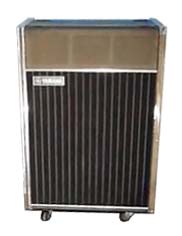

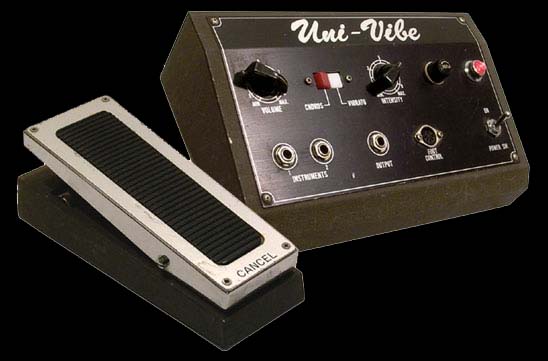
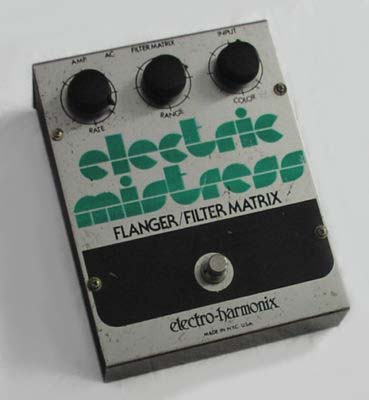
Yamaha RA-200 "Leslie" style rotating speaker cabinet, Vintage Univox Uni-Vibe and Electro-Harmonix 18v green Electic Mistress flanger used by David Gilmour in the 1970s through early 1980s
Left to right - Boss DD-2 Digital Delay, Boss DD-20 Giga Delay, T.C. Electronic Nova Delay, MXR Carbon Copy delay
An essential part of the Gilmour "wet" sound is delay, or echo. David always uses long delays to help create a his big, liquidy solo tones. Some people may think this is reverb, but David rarely, if ever, used reverb. Delay times can vary from 300 ms - 550 ms depending on the song, with 3-4 repeats. David used the Binson Echorec analog delay in the 1970s. He used an MXR Digital Delay System to simulate the sound of his old Echorec around the time of The Wall, and the Boss DD-2 digital delay. Around 1988 he replaced the MXR delay with the System II version. For the 1987-1990 Momentary Lapse of Reason and 1994 Division Bell tours David used a TC Electronic 2290 digital delay for his primary delay sound. In addition to creating his wet tone, David also used digital delays to play in time with on songs like Another Brick in The Wall Parts I and III, Run Like Hell, The Hero's Return, One Slip, and Take It Back.
There are two types of delays, analog and digital, and many modern delays create good representations of either type in the same unit. Analog sounding delay, whether real analog circuitry or a digital representation, are generally warmer sounding. Old analog tape delays had a limited limited bandwidth, causing the high frequencies gradually roll off with each echo repeat. They do not exactly recreat the sound of the original signal with each repeat, but that is part of the appeal of analog. Analog delays also tend to have slight imperfections, like modulation or warble, to the repeats. Modern analog delays attempt to recreate those effects. These delays are good for most of David's delay sounds, especially his 1970s work. Digital delays are more accurate recreations of the original signal, and sound very crisp and clear, with no degradation with each echo repeat. Digital delay is great for those songs that David plays in time with short delay repeats, like the triplet time delays in Run Like Hell, Another Brick in the Wall parts I and III from The Wall, Short and Sweet from his first solo album, Give Blood from Pete Townshend's White City, Blue Light from David's second solo album, About Face, The Hero's Return from Pink Floyd's The Final Cut, One Slip from A Momentary Lapse of Reason, and Take It Back from The Division Bell, among others. Analog delays work for these songs also, but digital really punches up the clarity of the triplet time rhythms. I have used several delays for Gilmour tones, my favorite being the TC Electonic Nova delay, which does very good digital and analog delay and slight modulations/tape effects, and featured nine programmable presets. Other good digital delays I have used over the years include the Boss DD-2, DD-3 (same chip as the DD-2), DD-20, and the Ibanez DE-7. All are good, accurate and clear digital delays. The DD-2 and DD-3 are great for songs like Another Brick I, II and Run Like Hell. The Electro-Harmonix Deluxe Memory Man, MXR Carbon Copy, and T Rex Replica delays are three other good analog delays that have a warm tape delay sound. These may be too warm sounding for the DSOT and Pulse tones, but work well for the 1970s Pink Floyd material. Having a programmable delay is a must in my book. Delay times vary on songs, so being able to select from preprogrammed delay times makes it much easier to change from song to song. I use 310, 380, 440, 540, and 620 millisecond delay times. Those cover just about any Gilmour or Pink Floyd song.
BOSS DD-2/DD-3 DELAY - The DD-2 was my first delay, and I still use it on my pedal board in combo with another programmable delay. A very simple mod to make this great sounding delay even better is a switchable hi cut mod to make the echo repeats warmer and more analog sounding. Below is a photo of my modded DD-3 (same circuit as the DD-2) with a toggle switch added to go between two different capacitors, for a slight hi cut and a more extreme hi cut. The middle position is the standard DD-2. Use a DPDT three way toggle switch (on/off/on) and two metal film capacitors (a .39uF/394k or .47uF/474k and a .1uF/104k) soldered across the volume pot. The smaller cap cuts the highs slightly, and the larger one cuts them more. More highs are removed each repeat, just like a typical analog tape delay hi cut. The mod takes about 15 minutes, if you are handy with a soldering iron. Here are instructions.
Some people are tempted to add amp reverb instead of using delay, but reverb will suck and color all the "Gilmour" out of your tone. If you must use it, I suggest keeping it dialed in low. I always have the reverb on when I use my Fender Twin Reverb, but never set above 3.
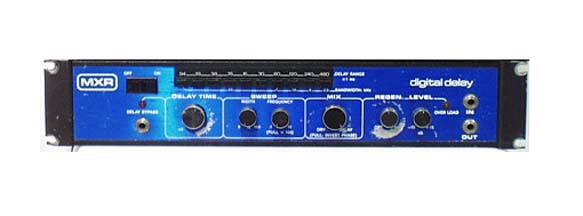
The Gilmour Delays - Vintage Binson Echorec II, MXR Digital Delay rack unit, MXR Digital Delay System II, and TC Electronic 2290 Digital Delay rack units
PARALLEL MIXING - David sometimes ran his delay signal parallel with the main signal. The main signal is split so one side goes straight through the pedal chain and one side goes through his delay, then both are mixed back together before they go into the amp. The reason for this is to keep the integrity of the original dry signal as pure as possible so there is no tone lost in the circuit of the delay. It also seems to makes the delay repeats sound smoother. A parallel system was used in David's On an Island Mark 2 pedalboard build by Pete Cornish.
To use a delay for parallel mixing, it needs to be able so send a signal out 100% wet, with just the echo repeats and no dry signal. Many delays do this, including the Boss DD-2 (you need to plug a dummy plug into one of the out jacks to get the other to send the wet signal only), Boss DD-3, Ibanez DE7, TC Electronics Nova Delay, Boss DD20 Delay, EHX Deluxe Memory Man, the old MXR Delay system II, and many others. You need a bypass loop mixer pedal that allows the dry signal to be split in two, then remixed back together. One side goes into a loop where you place your delay, then sent back to be mixed with the dry signal going straight through your pedal board. These bypass loop pedals usually include a buffer circuit to keep the signal balanced. The delay should be set to 100% wet so only the delay repeats are sent out, and none of the dry signal.
There are several mixer pedals that can be used for this. I have tried the Boss LS-2 Line Selector, the Radial Big Shot mixer, and the Barge VB Jr. With these pedals you can set the wet signal to mix 100% with the dry signal or mix for less wet. Be aware that mixing less may reduce your overall output volume because one side of the signal level is being reduced on several of these pedals. I have found it is better to keep the mix balanced and use a delay that has a volume control to change the delay level rather than reduce the wet level in the mixer.
Kit’s Secret Guitar, Gear, and Music Page
Guitar stuff, gear stuff, soundclips, videos, Gilmour/Pink Floyd stuff, photos and other goodies.
Copyright Kit Rae.
VISIT MY SWORDS, KNIVES and FANTASY ART WEBSITE www.kitrae.net

